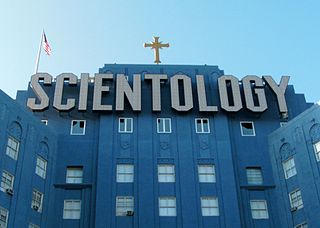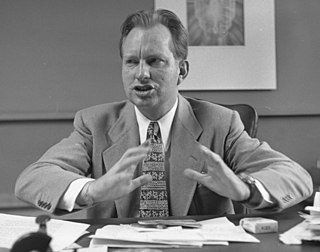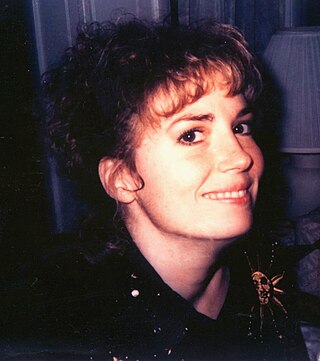
Dianetics is a set of pseudoscientific ideas and practices regarding the metaphysical relationship between the mind and body created by science fiction writer L. Ron Hubbard. Dianetics is practiced by followers of Scientology and the Nation of Islam.

Lafayette Ronald Hubbard was an American author, primarily of science fiction and fantasy stories, who is best known for having founded the Church of Scientology. In 1950, Hubbard authored Dianetics: The Modern Science of Mental Health and established a series of organizations to promote Dianetics. In 1952, Hubbard lost the rights to Dianetics in bankruptcy proceedings, and he subsequently founded Scientology. Thereafter, Hubbard oversaw the growth of the Church of Scientology into a worldwide organization.

Xenu, also called Xemu, is a figure in the Church of Scientology's secret "Advanced Technology", a sacred and esoteric teaching. According to the "Technology", Xenu was the extraterrestrial ruler of a "Galactic Confederacy" who brought billions of his people to Earth in DC-8-like spacecraft 75 million years ago, stacked them around volcanoes, and killed them with hydrogen bombs. Official Scientology scriptures hold that the thetans of these aliens adhere to humans, causing spiritual harm.
Revolt in the Stars is a science fiction film screenplay written by Scientology founder L. Ron Hubbard in 1977. It tells the space opera story of how an evil galactic dictator, named Xenu, massacres many of his subjects by transporting them to Earth and killing them with atomic bombs. L. Ron Hubbard had already presented this story to his followers, as a true account of events that happened 75 million years ago, in a secret level of Scientology scripture called Operating Thetan, Level III. The screenplay was promoted around Hollywood circles in 1979, but attempts at fundraising and obtaining financing fell through, and the film was never made. Unofficial copies circulate on the Internet.

In Dianetics and Scientology, auditing is a process whereby the "auditor" takes an individual through times in their current or past lives with the purpose of ridding the individual of negative influences from past events or behaviors. According to practitioners, auditing is meant to bring the individual to "Clear" status; thus, an individual being audited is known as a "preclear" or PC.

Dianetics: The Modern Science of Mental Health is a book by L. Ron Hubbard about Dianetics, a system that he developed from a combination of personal experience, basic principles of Eastern philosophy, and the work of Sigmund Freud, the founder of psychoanalysis. The book is a canonical text of Scientology. It is colloquially referred to as Book One. The book launched the movement, which later defined itself as a religion, in 1950. As of 2013, New Era Publications, the international publishing company of Hubbard's works, sells the book in English and in fifty other languages.

Scientology founder L. Ron Hubbard explicitly compared his teachings to the science-fiction subgenre space opera. In his writings, wherein thetans were reincarnated periodically over quadrillions of years, retaining memories of prior lives, to which Hubbard attributed complex narratives about life throughout the universe. The most controversial of these myths is the story of Xenu, to whom Hubbard attributed responsibility for many of the world's problems.

Since the founding of the Church of Scientology in 1954 by L. Ron Hubbard, the relationship between Scientology and psychiatry has been dominated by strong opposition by the organization against the medical specialty of psychiatry, and of psychology, with themes relating to this opposition occurring repeatedly throughout Scientology literature and doctrine. According to the Church of Scientology, psychiatry has a long history of improper and abusive care. The group's views have been disputed, criticized and condemned by experts in the medical and scientific community and been a source of public controversy.

MEST is an acronym for matter, energy, space and time, and means the physical universe. It was coined in 1950 by Scientology founder L. Ron Hubbard, and is spoken as a word rather than spelling out the letters.

Ronald Edward "Ron" DeWolf, also known as "Nibs" Hubbard, was the eldest child of Scientology's founder L. Ron Hubbard by his first wife Margaret Louise Grubb. He is known for having been highly critical of his father and of the Church of Scientology.

An engram, as used in Dianetics and Scientology, is a detailed mental image or memory of a traumatic event from the past that occurred when an individual was partially or fully unconscious. It is considered to be pseudoscientific and is different from the meaning of "engram" in cognitive psychology. According to Dianetics and Scientology, from conception onwards, whenever something painful happens while the "analytic mind" is unconscious, engrams are supposedly being recorded and stored in an area of the mind Scientology calls the "reactive mind".

History of Dianetics begins around 1950. During the late 1940s, L. Ron Hubbard began developing a mental therapy system which he called Dianetics. Hubbard had tried to interest the medical profession in his techniques, including the Gerontological Society, the Journal of the American Medical Association, and the American Journal of Psychiatry, but his work was rejected for not containing sufficient evidence of efficacy to be acceptable.

A Piece of Blue Sky: Scientology, Dianetics and L. Ron Hubbard Exposed is a 1990 book about L. Ron Hubbard and the development of Dianetics and Scientology, authored by British former Scientologist Jon Atack. It was republished in 2013 with the title Let's sell these people A Piece of Blue Sky: Hubbard, Dianetics and Scientology. The title originates from a quote of Hubbard from 1950; an associate of Hubbard's noted him saying that he wanted to sell potential members "a piece of blue sky".

This is a Timeline of Scientology, particularly its foundation and development by author L. Ron Hubbard as well as general publications, articles, books and other milestones.
OT VIII or OT 8 is the highest current auditing level in Scientology. OT VIII is known as "The Truth Revealed" and was first released to select high-ranking public Scientologists in 1988, two years after the death of Scientology's founder, L. Ron Hubbard. OT VIII is only delivered to members of the Church of Scientology in one place—aboard the organization's private cruise ship, the Freewinds, and is additionally available from independent Scientology groups. There are a few advanced auditors that are able to deliver the level to those who meet the prerequisites.
This bibliography of Scientology includes Scientology-related books authored by L. Ron Hubbard and those produced by the Church of Scientology and its related organizations. Books compiled by the Church of Scientology and published after the death of Hubbard are usually indicated as "Based on the Works of L. Ron Hubbard".

Brain-Washing: A Synthesis of the Russian Textbook on Psychopolitics is a Red Scare, black propaganda book, published by the Church of Scientology in 1955 about brainwashing. L. Ron Hubbard authored the text and alleged it was the secret manual written by Lavrentiy Beria, the Soviet secret police chief, in 1936. In this text, many of the practices Scientology opposes are described as Communist-led conspiracies, and its technical content is limited to suggesting more of these practices on behalf of the Soviet Union. The text also describes the Church of Scientology as the greatest threat to Communism.

Scientology is a set of beliefs and practices invented by the American author L. Ron Hubbard, and an associated movement. It has been variously defined as a cult, a business, or a new religious movement. Its adherents are called Scientologists. The largest exponent of Scientology is the Church of Scientology, a centralized and hierarchical organization based in Florida and California, although practitioners exist independently of the Church, in what is called the Free Zone. Estimates put the number of Scientologists at under 40,000 worldwide.

Scientology is suspected or alleged by some observers of being inspired by, or sharing elements with, a number of esoteric or occult systems.

This is a timeline of L. Ron Hubbard, founder of Scientology.







